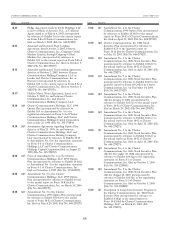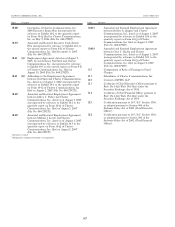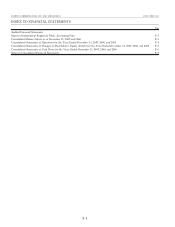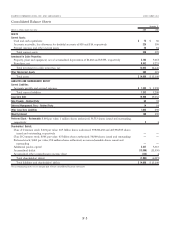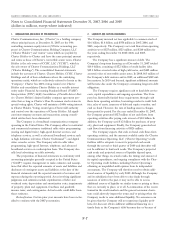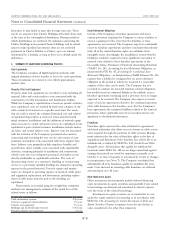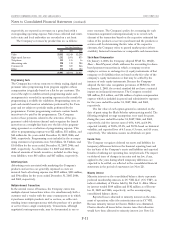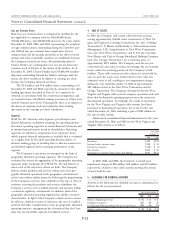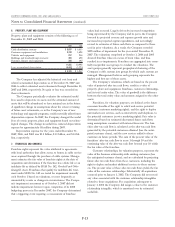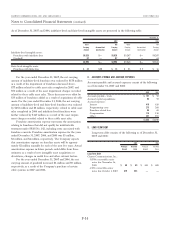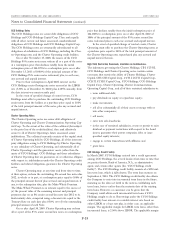Charter 2007 Annual Report Download - page 87
Download and view the complete annual report
Please find page 87 of the 2007 Charter annual report below. You can navigate through the pages in the report by either clicking on the pages listed below, or by using the keyword search tool below to find specific information within the annual report.
from time to time failed to meet this leverage ratio test. There
can be no assurance that Charter Holdings will satisfy these tests
at the time of the contemplated distribution. During periods in
which distributions are restricted, the indentures governing the
Charter Holdings notes permit Charter Holdings and its subsid-
iaries to make specified investments (that are not restricted
payments) in Charter Holdco or Charter, up to an amount
determined by a formula, as long as there is no default under the
indentures.
3. SUMMARY OF SIGNIFICANT ACCOUNTING POLICIES
Cash Equivalents
The Company considers all highly liquid investments with
original maturities of three months or less to be cash equivalents.
These investments are carried at cost, which approximates
market value.
Property, Plant and Equipment
Property, plant and equipment are recorded at cost, including all
material, labor and certain indirect costs associated with the
construction of cable transmission and distribution facilities.
While the Company’s capitalization is based on specific activities,
once capitalized, costs are tracked by fixed asset category at the
cable system level and not on a specific asset basis. For assets
that are sold or retired, the estimated historical cost and related
accumulated depreciation is removed. Costs associated with
initial customer installations and the additions of network equip-
ment necessary to enable advanced services are capitalized. Costs
capitalized as part of initial customer installations include materi-
als, labor, and certain indirect costs. Indirect costs are associated
with the activities of the Company’s personnel who assist in
connecting and activating the new service and consist of com-
pensation and indirect costs associated with these support func-
tions. Indirect costs primarily include employee benefits and
payroll taxes, direct variable costs associated with capitalizable
activities, consisting primarily of installation and construction
vehicle costs, the cost of dispatch personnel and indirect costs
directly attributable to capitalizable activities. The costs of
disconnecting service at a customer’s dwelling or reconnecting
service to a previously installed dwelling are charged to operating
expense in the period incurred. Costs for repairs and mainte-
nance are charged to operating expense as incurred, while plant
and equipment replacement and betterments, including replace-
ment of cable drops from the pole to the dwelling, are
capitalized.
Depreciation is recorded using the straight-line composite
method over management’s estimate of the useful lives of the
related assets as follows:
Cable distribution systems 7-20 years
Customer equipment and installations 3-5 years
Vehicles and equipment 1-5 years
Buildings and leasehold improvements 5-15 years
Furniture, fixtures and equipment 5 years
Asset Retirement Obligations
Certain of the Company’s franchise agreements and leases
contain provisions requiring the Company to restore facilities or
remove equipment in the event that the franchise or lease
agreement is not renewed. The Company expects to continually
renew its franchise agreements and have concluded that substan-
tially all of the related franchise rights are indefinite lived
intangible assets. Accordingly, the possibility is remote that the
Company would be required to incur significant restoration or
removal costs related to these franchise agreements in the
foreseeable future. Statement of Financial Accounting Standards
(“SFAS”) No. 143, Accounting for Asset Retirement Obligations,as
interpreted by FIN No. 47, Accounting for Conditional Asset
Retirement Obligations – an Interpretation of FASB Statement No. 143,
requires that a liability be recognized for an asset retirement
obligation in the period in which it is incurred if a reasonable
estimate of fair value can be made. The Company has not
recorded an estimate for potential franchise related obligations
but would record an estimated liability in the unlikely event a
franchise agreement containing such a provision were no longer
expected to be renewed. The Company also expects to renew
many of its lease agreements related to the continued operation
of its cable business in the franchise areas. For the Company’s
lease agreements, the estimated liabilities related to the removal
provisions, where applicable, have been recorded and are not
significant to the financial statements.
Franchises
Franchise rights represent the value attributed to agreements
with local authorities that allow access to homes in cable service
areas acquired through the purchase of cable systems. Manage-
ment estimates the fair value of franchise rights at the date of
acquisition and determines if the franchise has a finite life or an
indefinite-life as defined by SFAS No. 142, Goodwill and Other
Intangible Assets. All franchises that qualify for indefinite-life
treatment under SFAS No. 142 are no longer amortized against
earnings but instead are tested for impairment annually as of
October 1, or more frequently as warranted by events or changes
in circumstances (see Note 7). The Company concluded that
substantially all of its franchises qualify for indefinite-life treat-
ment. Costs incurred in renewing cable franchises are deferred
and amortized over 10 years.
Other Noncurrent Assets
Other noncurrent assets primarily include deferred financing
costs, investments in equity securities and goodwill. Costs related
to borrowings are deferred and amortized to interest expense
over the terms of the related borrowings.
Investments in equity securities are accounted for at cost,
under the equity method of accounting or in accordance with
SFAS No. 115, Accounting for Certain Investments in Debt and
Equity Securities. Charter recognizes losses for any decline in
value considered to be other than temporary.
F-9
CHARTER COMMUNICATIONS, INC. AND SUBSIDIARIES 2007 FORM 10-K
Notes to Consolidated Financial Statements (continued)


